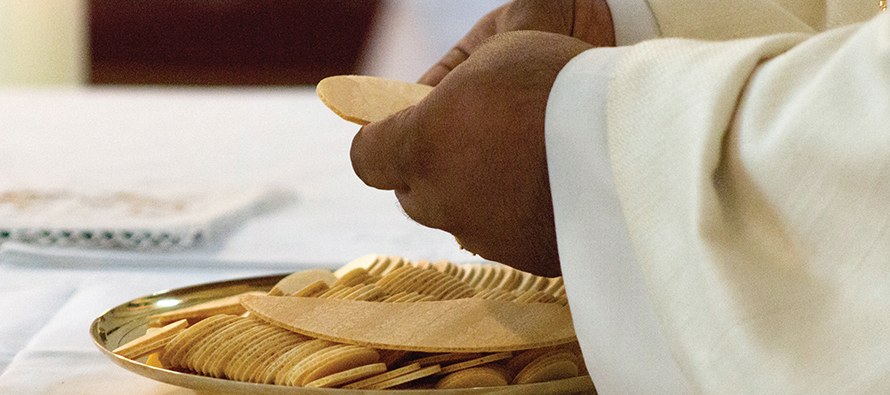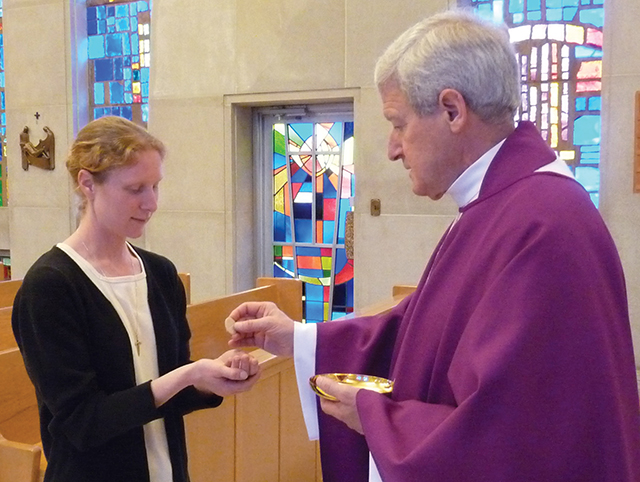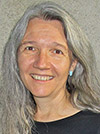What Catholics believe about the Eucharist

The Catholic belief in the Real Presence means Jesus Christ is present in the Eucharist in his Body and Blood, humanity and divinity, under the forms of bread and wine. (Photo: Pixabay)
OUR PARTICIPATION in the supper of the Eucharist transforms us into the Body of Christ for the world right now. That’s some statement!
The centrality of Eucharist to Catholic life can’t be overemphasized. It’s the “source and summit” of Christian life (Lumen Gentium, no.11). This means our life as disciples begins at the Table of the Lord and always returns here.
Eucharist means “thanksgiving.” Eucharist refers to the ritual of the Mass as a whole, or it can be shorthand for the Body and Blood of Christ we share in Communion. The Eucharist reminds us that what brings us together is gratitude. What are we grateful for? For many things personal and communal, but in the Mass we’re especially focused on the mystery of Christ who has died, is risen, and will come again in glory. This past, present, and future reality of Christ includes us in its magnificent unfolding. We’re not bystanders at a miracle, but participants in a never-ending feast.
Like many of our Protestant sisters and brothers, Catholics celebrate Eucharist as a memorial of the Last Supper Jesus shared with his friends. However, we also believe this sacrament renews the sacrifice Jesus makes of his life expressed in his words: “Take this, all of you, and eat of it, for this is my Body… Take this, all of you, and drink from it, for this is the chalice of my Blood….” What was, now is.
When the Early Church gathered for what they called the “breaking of the bread” or the “Supper of the Lord,” they did more than eat and drink. They also listened to instruction from local leaders, prayed, supported each other, shared financial resources with those in need, and received teachings from the apostles—whether in person, delivered by an eyewitness, or by means of a letter passed among the communities. Those gathered also served in a variety of ministries as the Spirit inspired them to do. We preserve these elements of Eucharist in the prayers, scripture readings, homily, and collection, as well as opportunities for faith formation and service practiced in various ways by each parish community.
More recently, church thinkers also direct our attention to the “dangerous memory” contained in our Eucharist. Christ’s Passion points to the reality of unjust suffering, the need for its redress, and the hope of transcendence from a world marred by sin and death. Our Eucharist reminds us that the call to justice sounds every time we “proclaim the death of the Lord, until he comes.”

Real means real
A question some wonder about is what Catholics mean when they talk about the Real Presence of Christ in the Eucharist. The clearest answer is the official one: Jesus Christ is present in the Eucharist in his Body and Blood, humanity and divinity, under the forms of bread and wine. The church teaches that this presence is not a metaphor, it’s a reality. Real.
Scripture
- Matthew 26:26-29; Mark 14:22-25; Luke 22:14-20; John 6:22-59; 1 Corinthians 11:23-26
- Acts of the Apostles 2:42; 4:32-35
Online
- Mysterium Fidei, encyclical of Pope Paul VI on the Holy Eucharist
- “What is the Eucharist?” by the United States Conference of Catholic Bishops
- “Why do Christians believe Jesus is God incarnate?” by Alice Camille
- “What is the Real Presence of Christ?” by Alice Camille
Books
- 101 Questions & Answers on the Eucharist by Giles Dimock, O.P. (Paulist Press, 2006)
- The Eucharist and the Hunger of the World by Monika K. Hellwig (Paulist Press, 1976)
- The Eucharist: A Mystery of Faith by Joseph M. Champlain (Paulist Press, 2005)
- The Eucharist and Social Justice by Margaret Scott (Paulist Press, 2009)
But how do we arrive at this idea? Jesus himself promises to be with us “always, to the end of time.” He promises to be present when two or more gather in his name, in the forgiveness of sins, and in the suffering world: “Whatever you did for one of these least . . . you did for me” (Matt. 25:40). Jesus promises to be really present in many ways throughout the gospel. He’s most explicit about being with us, however, in one profound way: “Take it; this is my body” (Mark 14:22). “I am the bread of life. . . . Whoever eats my flesh and drinks my blood has eternal life” (John 6:35, 54).
For nearly a millennium Christians didn’t dispute this understanding. The controversy began in the ninth century when it was suggested that the bread and wine were not physically changed but only signs of the presence of Christ among us. In response, the church formulated the idea of transubstantiation, in which the elements of bread and wine truly become the Body and Blood of Christ—as do we—in our participation in this sacrament.
This teaching is the basis for practices like Adoration of the Blessed Sacrament, prayer before the Eucharist, and processions that feature the Real Presence carried in a monstrance. Not all accepted this teaching, which influenced the reaction of the Reformation movement and the development of other ideas about the Eucharist among Protestants, largely accentuating its symbolism.
Return to our roots
In 1965 Pope Paul VI reiterated that Christ is present in prayer, works of mercy, preaching, teaching, sacraments, and uniquely in the Eucharist, “a way that surpasses all others” (Mysterium Fidei, no. 38). In 2022, the U.S. bishops organized the National Eucharistic Revival, which will include a national Eucharistic Congress in Indianapolis in July 2024. The culmination will be a year of “going out on mission” nourished by the Body of Christ. On eucharisticrevival.org the bishops explain why Catholics return again and again to this central sacrament:
Scandal, division, disease, doubt. The Church has withstood each of these throughout our very human history. But today we confront all of them, all at once. Our response in this moment is pivotal.
In the midst of these roaring waves, Jesus is present, reminding us that he is more powerful than the storm. He desires to heal, renew, and unify the church and the world.
How will he do it? By uniting us once again around the source and summit of our faith in the celebration of the Eucharist.
Parts of this article were originally published in “Questions Catholics Ask,” a section of VocationNetwork.org.
Related article: VocationNetwork.org, “Ten great things about being Catholic.”
Tags
Related
- Questions Catholics Ask
- How Jesus embraced his call
- Prayer: Our never-ending conversation with God
- What the church is teaching—and learning—about the sin of racism
- Church defined: Jesus calls; we respond
- A Creed to believe in
- On whose authority?
- Ten great things about being Catholic
- Following Jesus: Be ready for some surprises
- Enter into the divine Read More
Most Viewed
- Find your spirituality type quiz
- Questions and answers about religious vocations
- Celibacy quiz: Could I be a nun? Could I be a brother? Could I be a priest?
- Resources for older discerners or those with physical and developmental differences
- About Vocation Network and VISION Guide


